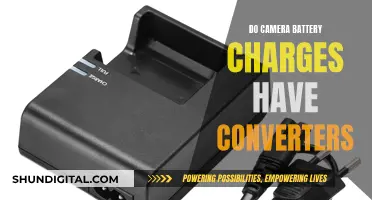
Wi-Fi doorbell cameras are a popular choice for those looking to enhance their home security. These devices combine a motion-activated camera, microphone, speaker, and doorbell, allowing users to monitor their front door and communicate with visitors remotely. While most of these devices require a wired power connection, there are battery-operated options available that provide flexibility in installation and are ideal for locations without existing wiring.
Battery-operated video doorbells, such as the Eufy Security Video Doorbell, utilize internal rechargeable batteries that typically offer several months of use before requiring recharging. They can be installed completely wirelessly or connected to existing doorbell wiring for trickle charging, eliminating the need for frequent battery replacements.
When choosing a doorbell camera, it's important to consider features like video quality, motion detection, alerts, and storage options. While cloud storage is common, some doorbells offer local storage through microSD cards, providing an alternative to cloud-based solutions that may raise privacy and security concerns.
In summary, battery-operated Wi-Fi doorbell cameras offer convenience, flexibility, and enhanced security for homeowners, providing peace of mind and a modern way to monitor your front door.
| Characteristics | Values |
|---|---|
| Installation | Easy and portable without the need for complicated wiring |
| Image Quality | Crisp 1080p grade view with advanced WDR for color-accurate, head-to-toe images |
| Battery Life | 120-day front door security via a low-power wireless connection between the doorbell and Wi-Fi chime |
| Dual Power Options | Half a year of coverage from one charge or continuous power via a wired connection |
| Advanced Features | Dual-cam technology, motion detection, and Delivery Guard™ for reliable alerts |
| Resolution | 2K resolution with HDR for crystal-clear video quality |
| Local Storage | Data is securely stored locally, meaning no Cloud Backup fees |
What You'll Learn

Wi-Fi doorbell cameras with local storage
Google Nest Doorbell
The Google Nest Doorbell is a reliable option that offers both cloud and local storage. It provides fast alerts and clear audio and video. With a Nest Aware subscription, you can access additional features like 24/7 recording and Familiar Face Detection. The device is compatible with Amazon Alexa and Google Home.
Aqara Video Doorbell G4
The Aqara Video Doorbell G4 offers both local and cloud storage options. It supports up to 512GB of local storage via a microSD card and provides free seven-day cloud storage. The doorbell has a modern design, excellent smart features, and a chime extender to ensure you never miss a visitor. It is compatible with multiple smart home platforms.
Blink Video Doorbell
The Blink Video Doorbell is an affordable option that offers local storage through a Sync Module 2. You can also opt for cloud storage with a Blink Subscription Plan for as low as $3 per month. The camera provides 1080p video resolution and is compatible with Amazon Alexa.
Eufy Security Video Doorbell E340
The Eufy Security Video Doorbell E340 offers both local and cloud storage options. It has 8GB of built-in storage for local storage and supports microSD cards for expandable storage. The doorbell features a dual-camera setup with a main 2K camera and a secondary 1080p camera to monitor packages. It is compatible with Amazon Alexa and Google Home.
Kasa Smart Video Doorbell KD110
The Kasa Smart Video Doorbell KD110 offers local storage through a microSD card of up to 128GB. It provides solid smart features, including people and motion detection, and is easy to use for monitoring your front door. The camera has a high 3MP resolution and is compatible with Amazon Alexa and Google Home.
These options provide a range of features and compatibility to suit your needs, ensuring that you can enhance your home security with a Wi-Fi doorbell camera that utilizes local storage.
Charging the WASP 4K Camera: A Step-by-Step Guide
You may want to see also

Ethernet-powered doorbell cameras
Power over Ethernet (PoE) doorbells differ from regular smart doorbells by using a single ethernet cable to power the doorbell and connect it to the internet. This means that, unlike Wi-Fi doorbells, they don't need a separate power supply or electrical wiring.
Advantages of PoE doorbells
PoE doorbells offer a plug-and-play installation that saves time and money on complicated wiring jobs and network configuration. They also transmit data faster than Wi-Fi, support a stable network connection, and enjoy a constant power supply.
Disadvantages of PoE doorbells
PoE doorbells may require professional cabling work, and there may be distance limits on the cables. They can also be more expensive than other types of doorbells, and there are fewer models available on the market.
PoE doorbell recommendations
The Ring Video Doorbell Elite is a popular choice for a PoE doorbell, offering compatibility with a wide range of home automation devices, strong PoE performance, and a good camera. The DoorBird D101S is a premium option with easy integration with smart home products, while the GBF Upgraded WiFi Video Doorbell is perfect for controlling electric locks. The Reolink Video Doorbell PoE is another good budget option, offering advanced video quality, audio functions, and smart features for under $100.
Wi-Fi doorbell cameras that run on battery power
Wi-Fi doorbell cameras that run solely on battery power are also available. These offer the advantage of easy installation and portability, but may require more frequent recharging and may not have the same level of performance as wired doorbells. Examples include the Eufy Video Doorbell range and the Feit Electric Smart Video Doorbell Camera.
Charging the Fujifilm XP80: A Step-by-Step Guide
You may want to see also

Wi-Fi doorbell cameras with cellular backup
One example of a doorbell camera with cellular backup is the Ring Battery Doorbell Plus. This model offers head-to-toe view, high-quality video resolution, and fast response times. It also works great with Amazon Alexa and can record locally to a Ring Alarm Pro. However, the battery life is only about two months.
Another option is the Ring Video Doorbell Pro 2, which offers excellent video quality, good connectivity, and accurate motion detection. It works smoothly with Amazon Alexa and integrates with Ring Alarm and other Ring cameras. However, it is expensive and requires a subscription for most features.
It's important to note that doorbell cameras with cellular backup may come with additional monthly fees for the cellular service, so be sure to factor that into your decision.
Charging the Nokia Camera: A Quick Guide
You may want to see also

Battery life and charging
The battery life of a Wi-Fi doorbell camera varies depending on the model and usage. On average, the battery can last anywhere from one month to six months before requiring a recharge. For example, the Eufy Security Video Doorbell S220 (Battery-Powered) Kit, Security Camera - 2K Resolution, 180-Day Battery Life, Encrypted Local Storage, No Monthly Fees, Built-in Storage, Motion Only Alert lasts up to six months with regular use. The Ring Video Doorbell Wired is another example of a battery-powered doorbell camera that lasts up to four months with regular use.
The Eufy Security Video Doorbell S220 (Battery-Powered) Kit is a great option for those seeking a long-lasting battery life. It offers a 2K resolution, 180-day battery life, encrypted local storage, and no monthly fees. The built-in storage is a convenient feature that allows you to store footage directly on the device without the need for a cloud subscription.
In terms of charging, the time it takes to charge a battery-powered Wi-Fi doorbell camera depends on the charger and the battery capacity. Generally, 1080P or 2K wireless battery doorbells use a 5000mAh or 6500mAh battery, which may take about 3-6 hours for a full charge, depending on the charger. It's important to note that battery-operated doorbell cameras need to be recharged periodically, usually every few weeks or months, to ensure proper functioning.
Some models, like the Feit Electric Smart Video Doorbell Camera, offer the flexibility of combining wired and battery power. This particular model uses a rechargeable 6700 mAh battery, ensuring that the camera continues to operate even during power outages. Additionally, it provides the option to hardwire it into the existing electrical wiring or connect it wirelessly to a compatible wireless door chime.
When choosing a battery-powered Wi-Fi doorbell camera, it is essential to consider factors such as battery life, charging time, storage options, and compatibility with smart home systems. These features will ultimately determine the convenience and effectiveness of your doorbell camera system.
Charging Waterproof Double-Screen Cameras: A Step-by-Step Guide
You may want to see also

Wired vs. wireless doorbell cameras
When it comes to choosing between a wired and a wireless doorbell camera, there are several factors to consider. Both options have their own set of advantages and disadvantages, and the right choice for you will depend on your specific needs and preferences. Here is a detailed comparison to help you make an informed decision:
Wired Doorbell Cameras:
- Pros: Wired doorbell cameras offer a continuous power supply, eliminating the need for frequent battery changes. They provide uninterrupted coverage, making them ideal if you have serious security concerns. They are also less prone to interference from other wireless connections. In addition, they continue to function even during an internet outage and typically require low to no maintenance. There is a wide range of design options available, including various colours, shapes, and styles. Moreover, you don't need to remember to change or charge the battery.
- Cons: One of the main drawbacks of wired doorbell cameras is the complicated installation process. They are generally more challenging to install than wireless doorbells, especially for those without prior experience. Older homes may require an upgraded transformer to work with newer or video doorbell models. Removing a wired doorbell after installation can be difficult, so you may need to purchase a new one when you move.
Wireless Doorbell Cameras:
- Pros: Wireless doorbell cameras offer flexibility in placement. They are battery-operated and do not require any wiring for installation, allowing you to mount them anywhere near your front door. This makes them a good choice if you're looking for a simple installation process, as you only need to install the bracket, sync the camera with your Wi-Fi and smartphone, and you're ready to go. They are easy to integrate with other smart devices around your home and allow you to personalise the chime. You can set up motion-activated alerts and receive notifications directly on your phone. Wireless doorbells often have a sleek design, reducing the number of cords and wires. Since they connect to the internet, you'll always have access to the latest software and operating system.
- Cons: One of the main disadvantages of wireless doorbell cameras is the need for periodic recharging. The batteries typically last for a few months, so you'll need to have a charged backup battery ready to avoid any downtime. Wireless doorbells can be more expensive than wired ones, and their designs are often simplistic and limited. They require a working internet connection to view live footage, and there is a possibility of radio interference due to the use of radio signals.
In summary, if you prioritise ease of installation and flexibility in placement, a wireless doorbell camera may be the best option. On the other hand, if you require continuous coverage and want to avoid frequent battery changes, a wired doorbell camera could be more suitable. Ultimately, the decision depends on your specific needs, budget, and preferences.
Camera B500 Charging: Cable or No Cable?
You may want to see also
Frequently asked questions
No, a Wi-Fi doorbell camera can be battery-powered. However, if you have existing doorbell wiring, it is recommended to use it as it provides a more reliable power source and eliminates the need for frequent recharging.
The battery life of a Wi-Fi doorbell camera can vary depending on usage and the specific model. On average, they can last anywhere from one to six months before requiring a recharge.
The charging method depends on the model. Some batteries are removable and can be charged using a standard USB charger. Others may require you to remove the entire doorbell unit and bring it inside for charging.
Yes, in most cases, you can use your existing doorbell chime with a Wi-Fi doorbell camera. However, some models may require you to purchase a separate chime or use a smart speaker as an indoor chime.
Battery-powered Wi-Fi doorbell cameras offer flexibility and portability. They are easy to install and can be placed anywhere around your door, even in locations where traditional wired setups are not feasible. They also eliminate the need for complicated wiring.







